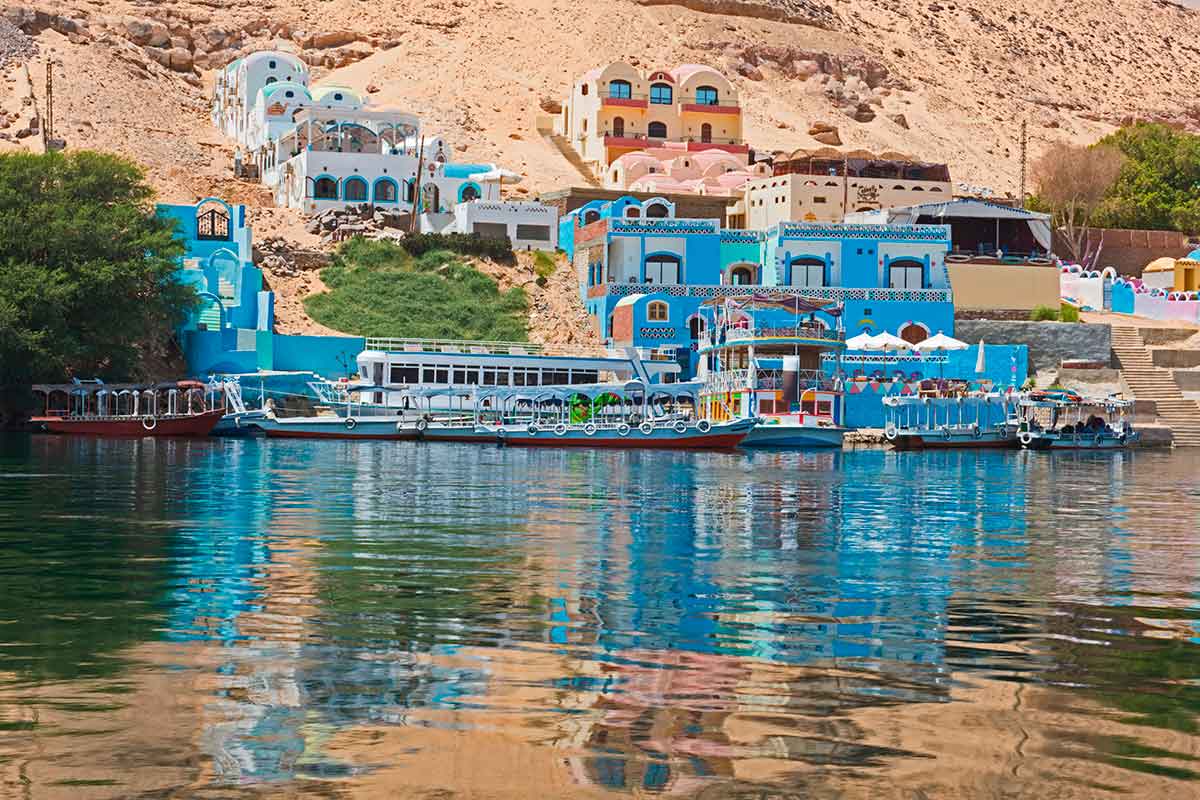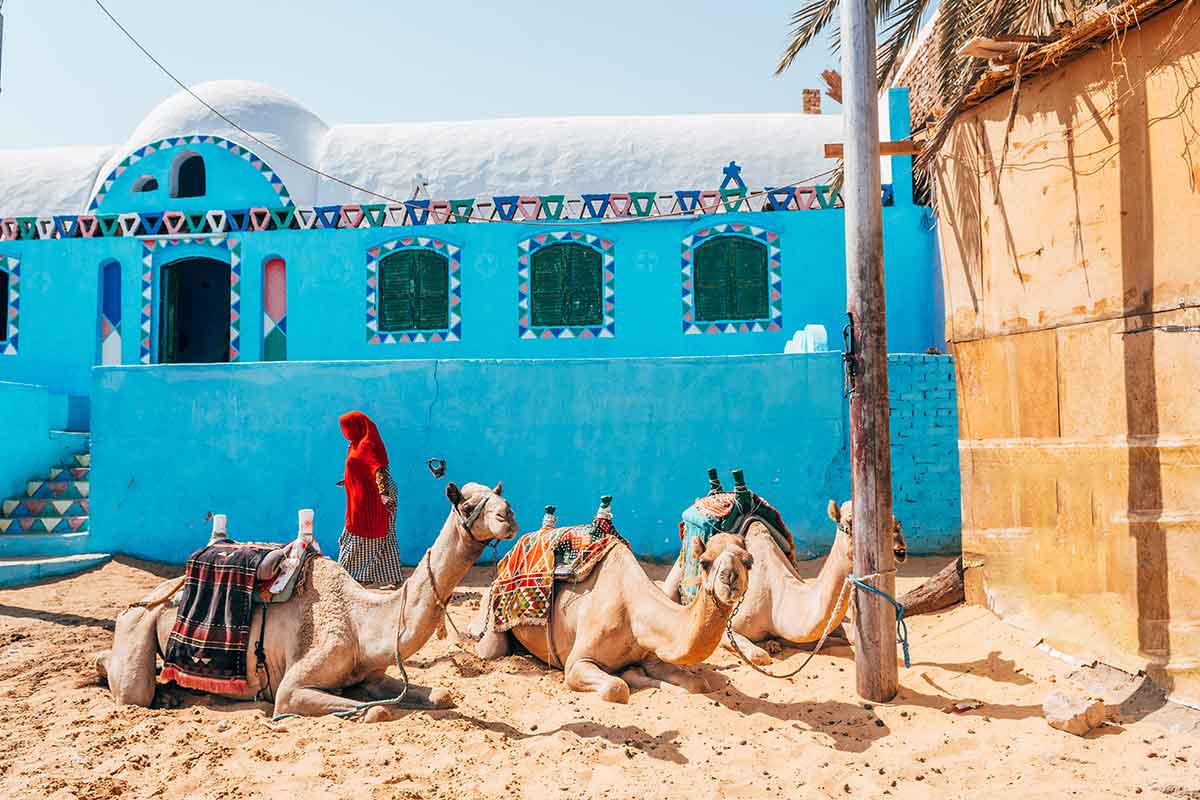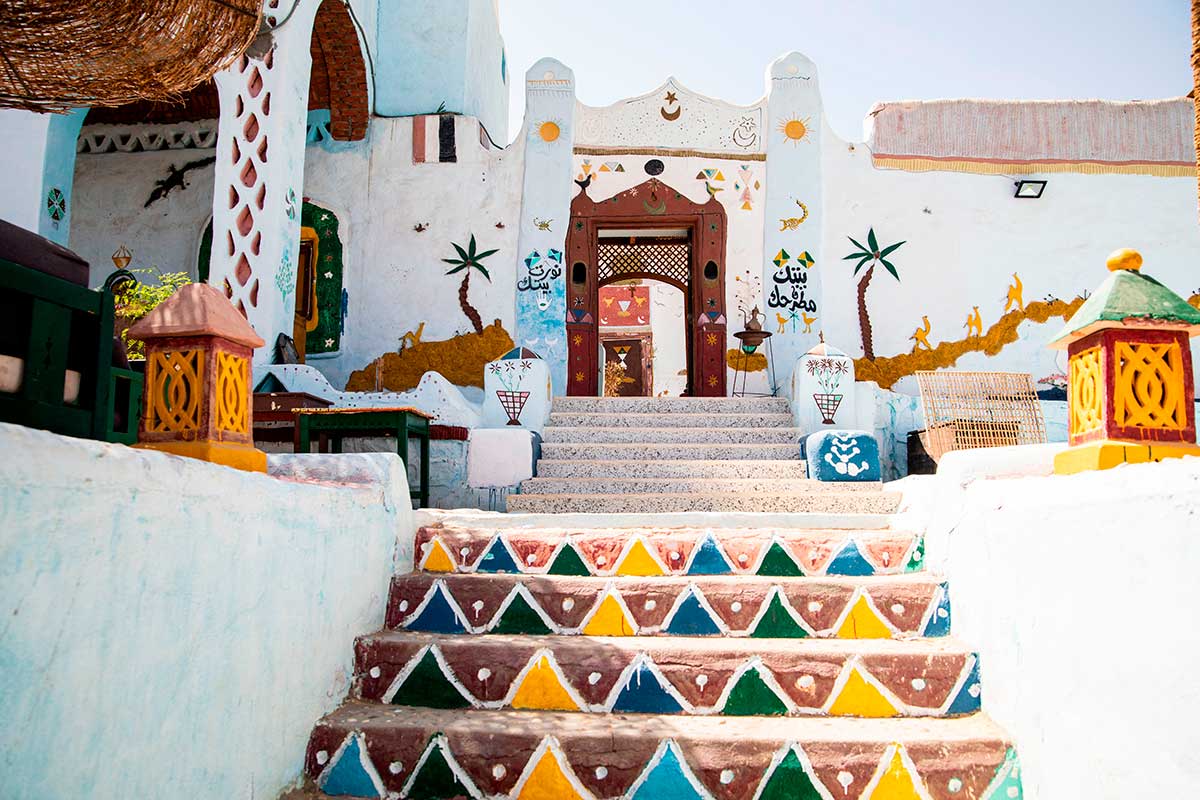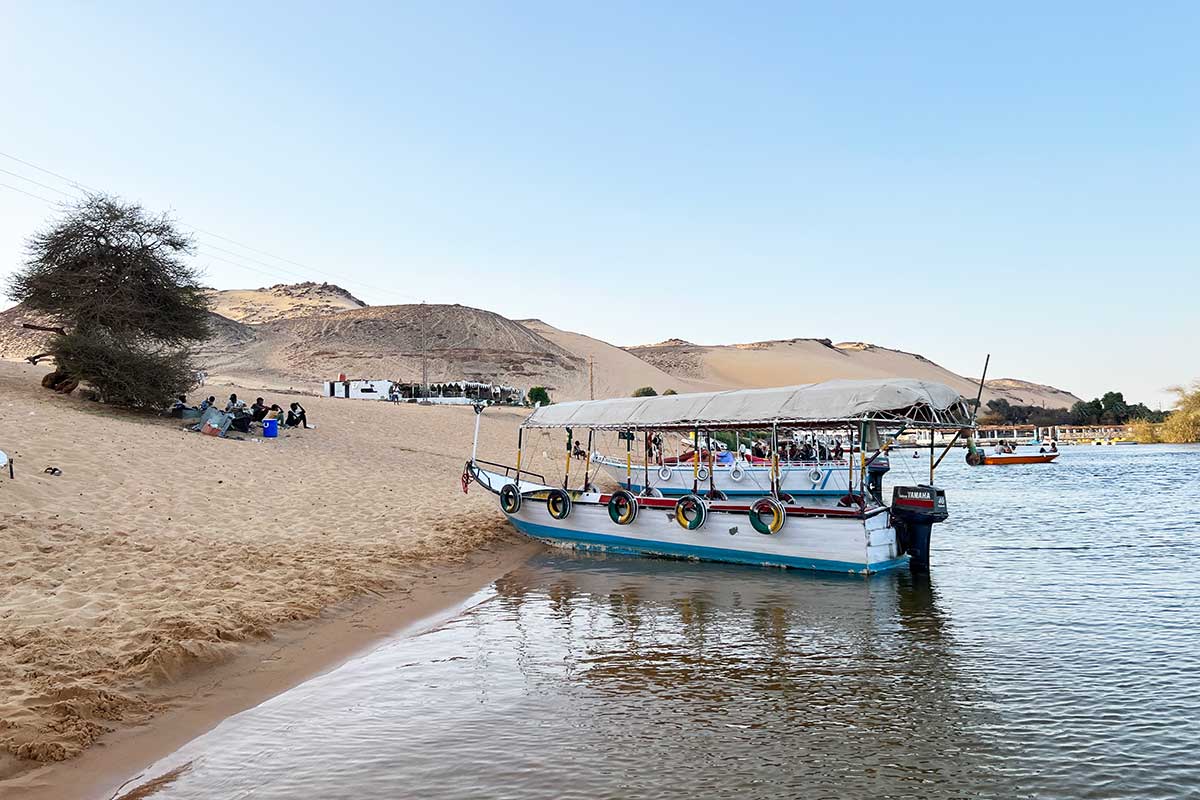If you’re a traveler who wants to explore more than just the pharaonic monuments of Egypt, then discovering the unique culture and traditions of Nubia, located in the southern part of the country, should be on your itinerary. On this page, we’ll provide you with key insights into the Nubian people, from their fascinating history to their physical traits and cultural manifestations. And, if you want a truly immersive experience, Egipto Exclusivo can organize a customized trip focused on Nubia, including visits to Nubian villages and cultural shows.
You won’t find Nubia on a map as it’s not a state or governorate in either Egypt or Sudan, its southern neighbor. Historically, Nubia was the area between the first cataract of the Nile in Aswan, Egypt, and the sixth cataract in Khartoum, Sudan.
In Egypt, Lower Nubia, between the first and second cataracts, was part of the country until the construction of the High Aswan Dam and the formation of Lake Nasser, which submerged the entire area.

Today, it’s more appropriate to refer to the “Nubian people” rather than Nubia as a defined territory in Egypt. The Nubians can be found dispersed across different areas where they strive to preserve their culture and prevent their history from being forgotten.
Some Nubians chose to remain in Aswan, a city with a strong connection to their population. Most Nubian villages are located on Elephantine Island, while Nubian structures can also be seen throughout the city and on the western bank of the Nile. These structures may serve as homes or even cafes.
Others have migrated northwards, forming a significant community in the city of Kom Ombo and Nasr Nouba. Some have even journeyed to Cairo, although they are generally integrated without forming distinct Nubian neighborhoods or villages as they have in Aswan.
As mentioned earlier, the territory of Nubia in Egypt was known as Lower Nubia, with Upper Nubia corresponding to Sudan. It’s also interesting to note that it was previously referred to as Lower Ethiopia. This is relevant because the main character in Giuseppe Verdi’s opera Aida, set in ancient Egypt, is an Ethiopian princess who is actually a Nubian character.
Physically, the Nubians are easily distinguishable – they are generally taller with darker skin, although many of them have surprisingly light-colored eyes. In fact, the term ‘Ethiopian’ was used by the ancient Greeks and maintained by the Romans to refer to them, and it meant “those with burnt faces,” in reference to the color of their complexion.
The Nubians also have their own language, which is related to others in Sudan. Due to this and many other unique aspects of Nubian culture, they are considered an ethnic group that is distinct from the rest of those who inhabit Egypt. They are clearly differentiated from the majority Arab group and other minority groups, such as the Bedouins of Sinai, the Berbers of Siwa, or the Gypsies.

The history of Lower Nubia presents periods in common with Egypt, but also stages of its own development, related to its neighbors to the south (modern-day Sudan), with whom it has always had a great political and cultural affinity. Here we briefly review all of this
The history of the Nubian people dates back to ancient times and is closely intertwined with that of Ancient Egypt, as well as its contemporary neighbor to the south: the Kingdom of Kush, which occupied the stretch of the Nile Valley in present-day Sudan. The term “Cushite” is also used synonymously with “ancient Nubian.” The Kingdom of Kush was a distinctly Nubian political and administrative entity with which Egyptian pharaohs traded and competed.
Wawat, situated between the first and second cataracts (already in Sudanese territory) of the Nile (where Aswan is located today), was located between Ancient Egypt and the Kingdom of Kush. Egyptian monarchs mostly controlled Wawat throughout history. During periods of territorial expansion and splendor, some pharaohs subdued certain parts of this kingdom, such as Sesostris I and Sesostris III during the Middle Kingdom’s 12th Dynasty. On other occasions, the border between Ancient Egypt and the Kingdom of Kush served as a place to display pharaonic propaganda, such as Ramses II’s act of showcasing his strength to the Nubians through Abu Simbel.
Pharaonic Egypt’s interest in Nubia was largely due to the abundance of gold in its mines. Although gold was also extracted from some mines located in closer places such as Kom Ombo, or even imported from other territories in Asia, the gold deposits in Nubia were probably the best. In fact, the name the ancient Egyptians gave to this area was Nebu, which means “the land of gold,” and that could be the origin of the current name.
However, in certain periods of pharaonic weakness, the Kingdom of Kush extended its power or influence over Wawat. An example of this was the Second Intermediate Period when the invasion of the country by the Hyksos led to a cushite dynasty taking control of Wawat or Lower Nubia. Even more significant implications were had by the 25th Dynasty, originating from Napata, the capital of the Kingdom of Kush. In the 8th and 7th centuries BC, the 25th Dynasty extended its power beyond Lower Nubia, first in Upper Egypt and then throughout the country, reunifying it under the command of the cushite king Shabako and displacing the XXII, XXIII, and XXIV dynasties, which ruled contemporaneously in other regions of Ancient Egypt.
In the mid-7th century BC, the cushites began to retreat to their original territory, which ultimately proved decisive: defeated and pushed by the Assyrians, Napata began to lose power in favor of Meroe, which had already replaced it in its role as capital by the 4th century BC. Then, a period of change occurred: the Kingdom of Meroe, whose capital was further away from the border with Egypt, distanced itself from its northern neighbors, and its culture became more Africanized. Nevertheless, some manifestations related to the Egyptians persisted in the Nubian people, such as the famous Pyramids of Meroe.
After this transitional period, Lower Nubia came to be viewed as a buffer zone between Egypt and Meroe, with some aspects showing the influence of the Ptolemaic rulers on the Nubian people. For example, temples built during this era were later relocated to other countries after the construction of Lake Nasser in the 1960s, as part of archaeological efforts in the region. One such temple is the Temple of Debod in Madrid, originally constructed in Lower Nubia during this time.
During this period, religion was a blend of the Egyptian pantheon and local deities. However, one of the most significant legacies of the Greco-Roman period (4th century AD) was the introduction of Christianity, which was brought to Nubia by monks and hermits. The message of Christianity took root and led to the conversion and adaptation of many temples in Lower Nubia. The other etymology of Nubia, Nobatia, may also have originated from this period, as the Romans referred to the area by this name.
After the Greco-Roman period, the region was known as Nobatia, which later established itself as an independent Christian kingdom with its capital in Faras (4th-6th centuries). However, faced with the Arab advance in Egypt in the mid-7th century, Nobatia formed an alliance with Makuria, another Christian Nubian kingdom with its capital in Dongola. This union provided the initial resistance to the Muslim conquest attempt, which the Nubians defended themselves against with guerrilla strategies and skirmishes.
Despite their efforts, Lower Nubia gradually became culturally Arabized, losing commercial contact with Aswan, the southern border city of Egypt. The collapse of the kingdom of Dongola in the 14th century led to Lower Nubia coming under Egyptian rule, with Islam as the main religion. Nonetheless, Christianity maintained a strong presence in Egyptian lands well into the Middle Ages, and Nubians continue to attend churches as Coptic believers in both Egyptian and Sudanese territory, as seen in Aswan today.
During the 19th century, under the rule of Mehmet Ali, Egypt extended its control over Nubia further south, to the kingdom of Sennar, which had been an independent sultanate for several centuries. However, British colonization drastically altered the political landscape of the region. When the British Protectorate came to an end in the early 20th century, Nubia was definitively divided between Egypt (Lower Nubia) and Sudan (Upper Nubia).
However, Lower Nubia’s existence was short-lived, as the waters of Lake Nasser submerged all the villages from the first cataract to almost the second in the 1960s, effectively submerging almost all of Lower Nubia. As a result, the Nubian people were forced to relocate their homes to other areas, as mentioned previously.

Nubian culture is still very much alive in Egypt, despite the loss of Lower Nubia’s territory. Efforts have been made to preserve their culture, which can now be experienced through excursions to Nubian villages and ethnographic experiences. Here are some of the main features of Nubian culture:

A trip to a Nubian village is the perfect way to experience the culture of this unique people. You’ll have the chance to stroll through the colorful streets and admire the distinctive architecture of their adobe houses adorned with beautiful drawings.
Sadly, due to the creation of Lake Nasser, many Nubian villages were lost underwater. However, there are still a few settlements that remain, and they have become popular destinations for travelers. Here are two recommended villages that you can visit with the help of our travel agency.
Gharb Soheil is a highly recommended excursion for anyone interested in experiencing a Nubian village. Its location, about five kilometers from the center of Aswan, makes it easily accessible by boat. The village is located on the western bank of the river, beyond the island of Sehel, and just before the High Dam, which adds to its charm.
It is considered the best excursion to a Nubian village because it closely resembles the small towns that existed on the banks of the Nile in Lower Nubia before they were flooded by Lake Nasser. The streets are filled with colorful houses and a bustling atmosphere, including a street market. This excursion provides travelers with a unique glimpse into Egypt’s culture. Visitors can explore the village’s original establishments and even enter some houses, as owners willingly show them around.
The excursion to the Nubian village of Elephantine Island, located in the course of the Nile as it passes through Aswan, is another fascinating option for any traveler interested in Nubian culture. Unlike the journey to Gharb Soheil, the attraction of this excursion lies in the richness of cultural proposals that exist in the surroundings, rather than the journey itself.
Furthermore, some of the great tourist attractions of Aswan are located in the immediate vicinity of Elephantine Island. Visitors can explore the pharaonic period temples and visit the Aswan Museum, which houses a rich collection of ancient artifacts. Additionally, Animalia, a humble space where native animals are exhibited, is located in the area and is another great opportunity to learn more about Nubian culture.
While visiting a Nubian village is a great way to immerse oneself in the culture, there are also other ways to learn about Nubian traditions and customs. Here are a few suggestions to consider during your travels to Aswan:
Egipto Exclusivo can help you experience any of these options by reserving services and connecting you with knowledgeable professionals who live in Nubian villages or have a deep understanding of Nubian culture. Don’t miss out on the opportunity to add an ethnographic and cultural experience to your trip to Egypt!


Fill out the form below to receive a free, no-obligation, tailor-made quote from an agency specialized in Egypt.
Travel agency and DMC specializing in private and tailor-made trips to Egypt.
Mandala Tours, S.L, NIF: B51037471
License: C.I.AN-187782-3